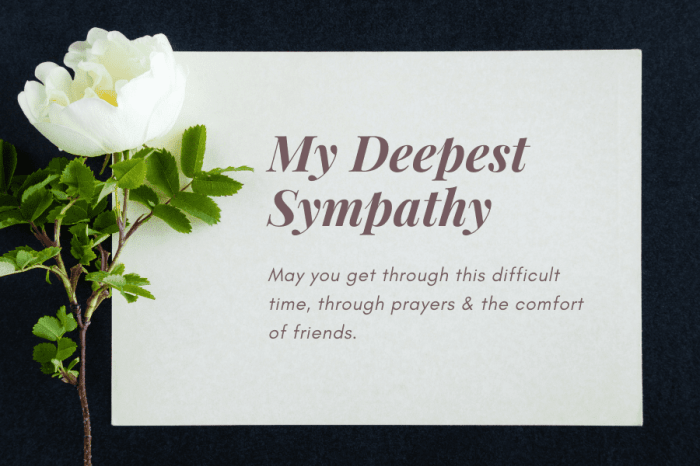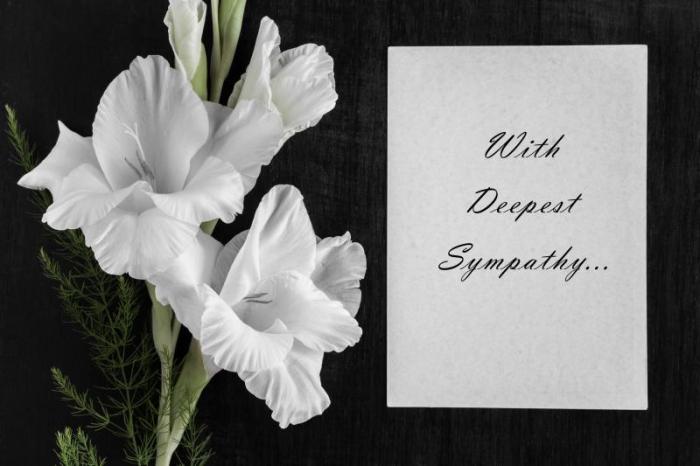In times of profound sorrow, expressing condolences to the bereaved can be a daunting task. Burial condolence messages hold immense significance as they convey empathy, comfort, and support to those who have lost a loved one. This comprehensive guide explores the common themes, cultural variations, effective language choices, and proper etiquette associated with burial condolence messages, providing valuable insights into creating meaningful expressions of sympathy.
With sensitivity and understanding, this guide delves into the nuances of expressing condolences, offering practical tips and guidelines to navigate the complexities of this delicate task. Whether you’re writing a heartfelt card, delivering a eulogy, or sending a message of support online, this guide equips you with the knowledge and tools to convey your condolences in a genuine and comforting manner.
Exploring Common Themes in Burial Condolence Messages
Burial condolence messages often convey a mix of emotions and expressions of support. These messages can vary in tone and style, yet they share common themes that aim to provide comfort and support to the bereaved during their time of grief.
One common theme in burial condolence messages is the expression of sympathy and empathy. This is often conveyed through phrases like “I am so sorry for your loss” or “My heart goes out to you during this difficult time.” These expressions acknowledge the pain and sorrow that the bereaved are experiencing and let them know that others care about them.
Acknowledging the Deceased
Another common theme is the acknowledgment of the deceased. This can be done by sharing fond memories or expressing admiration for the person’s life and accomplishments. This helps to validate the grief that the bereaved are feeling and reminds them of the positive impact that their loved one had on others.
Offering Support and Assistance
Burial condolence messages often include offers of support and assistance. This can range from practical help, such as offering to run errands or provide meals, to emotional support, such as listening to the bereaved talk about their grief or simply being present for them.
These offers of support can be a lifeline for the bereaved, helping them to cope with the overwhelming emotions and challenges that they are facing.
Expressing Hope and Faith
Many burial condolence messages also express hope and faith. This can be done by reminding the bereaved of the eternal life that awaits the deceased or by sharing stories of personal experiences with grief and loss. These expressions of hope and faith can provide comfort and strength to the bereaved, helping them to find meaning and purpose in their loss.
Cultural and Religious Variations in Burial Condolence Messages

Condolence messages during burial ceremonies vary significantly across cultures and religions, reflecting diverse beliefs and practices surrounding death and mourning. Understanding these variations can help us appreciate the nuances of different cultures and express our sympathies in a respectful and meaningful way.
In many Western cultures, burial condolence messages often emphasize the concept of eternal life or a better afterlife. Common phrases include “May they rest in peace” or “They are now in a better place.” These messages offer comfort and hope to the bereaved, suggesting that the deceased has found peace and happiness in the afterlife.
Religious Variations
In many Christian traditions, burial condolence messages often draw upon biblical passages and teachings. Phrases like “Blessed are those who mourn, for they shall be comforted” (Matthew 5:4) or “For I am convinced that neither death nor life, neither angels nor demons, neither the present nor the future, nor any powers, neither height nor depth, nor anything else in all creation, will be able to separate us from the love of God that is in Christ Jesus our Lord” (Romans 8:38-39) offer solace and assurance to the grieving.
In Buddhist traditions, condolence messages may focus on the concept of reincarnation and the interconnectedness of all living beings. Phrases like “May they find peace and happiness in their next life” or “May they be reborn into a better realm” express the belief that the deceased’s spirit will continue to exist in another form.
In Islamic traditions, burial condolence messages often emphasize the submission to God’s will and the inevitability of death. Phrases like “Inna lillahi wa inna ilayhi raji’un” (Verily we belong to God, and verily to Him do we return) or “May Allah grant them a place in Jannah (Paradise)” reflect the belief in God’s sovereignty and the hope for the deceased’s eternal reward.
Effective Wording and Language Choices in Burial Condolence Messages
Expressing condolences during a time of grief requires sensitivity, empathy, and careful consideration of language. The words you choose can provide comfort and support to the bereaved, or they can inadvertently cause further pain. Here are some guidelines for choosing appropriate and effective language when expressing condolences:
Use Empathetic and Sincere Language
Your words should convey genuine empathy and understanding of the pain the bereaved is experiencing. Avoid using generic or clichéd phrases that may come across as insincere or dismissive. Instead, focus on expressing your heartfelt condolences and acknowledging the loss.
Use language that shows you genuinely care and are there to support them.
Avoid Clichés and Generic Phrases
Clichés and generic phrases, such as “I know how you feel” or “Everything happens for a reason,” can be hurtful and dismissive. These phrases may imply that you understand the bereaved’s pain when you cannot fully comprehend it. Instead, opt for more personalized and sincere expressions that show you have taken the time to consider their unique situation.
Be Specific and Personal
When expressing condolences, try to be as specific and personal as possible. Mention the deceased’s name and highlight their positive qualities or the special bond you shared with them. This shows the bereaved that you remember and value their loved one.
You can also share a fond memory or anecdote that captures the essence of the deceased’s personality or the relationship you had with them.
Offer Practical Support
In addition to expressing your condolences, consider offering practical support to the bereaved. This could involve offering to help with funeral arrangements, providing meals or groceries, or simply being present for them during this difficult time. Let them know that you are there for them in any way they need, whether it’s running errands, providing emotional support, or simply listening to them.
Use Respectful and Appropriate Language
When expressing condolences, it’s important to use respectful and appropriate language. Avoid using slang, profanity, or any language that may be offensive or hurtful. Remember that the bereaved are going through a difficult time, and your words should be a source of comfort and support, not additional pain.
Be Mindful of Cultural and Religious Differences
Be mindful of cultural and religious differences when expressing condolences. Different cultures and religions have different customs and traditions surrounding death and mourning. Research or inquire about the specific customs and beliefs of the bereaved family to ensure that your words and actions are respectful and appropriate.
Personalizing Burial Condolence Messages
Personalizing burial condolence messages is crucial to show genuine empathy and support to the bereaved. A personalized message reflects the unique relationship between the sender and the deceased, making it more meaningful and comforting.
Sharing Personal Anecdotes and Memories
Share specific anecdotes or memories that highlight the positive qualities and cherished moments shared with the deceased. These personal stories can evoke emotions and create a sense of connection between the sender and the bereaved.
- Recall a funny incident or a heartwarming experience that showcases the deceased’s personality and character.
- Mention a shared hobby, interest, or passion that you enjoyed together, emphasizing the bond you had.
- Share a meaningful conversation or a piece of advice that the deceased gave you, expressing how it impacted your life.
Acknowledging the Deceased’s Impact
Acknowledge the positive impact the deceased had on your life or the community. Express how their presence enriched your life and the lives of others.
- Mention how the deceased’s kindness, wisdom, or humor brought joy to those around them.
- Share how their contributions made a difference in their field of work, community, or personal relationships.
- Express gratitude for the lessons learned and the memories created with the deceased.
Offering Comfort and Support
Offer comfort and support to the bereaved by expressing your understanding of their grief and assuring them of your presence during this difficult time.
- Emphasize that you are there to listen, provide support, and assist in any way possible.
- Acknowledge that grief is a natural process and that it takes time to heal.
- Offer practical help, such as assistance with funeral arrangements, errands, or childcare.
Etiquette and Protocol for Sending Burial Condolence Messages
Offering condolences during a time of bereavement requires sensitivity and respect. Here are some guidelines to ensure proper etiquette and protocol when sending burial condolence messages:
Timing
Timing is crucial in conveying empathy and support. Generally, it’s best to send your condolences promptly after learning of the loss, while the family is still in the initial stages of grief. However, avoid sending messages immediately after the news is announced, as the family may be overwhelmed with arrangements.
Methods of Delivery
There are several appropriate methods for sending burial condolence messages:
- In person: If possible, visiting the family in person is the most heartfelt way to offer condolences. Your physical presence and sincere words can provide comfort during their difficult time.
- By mail: Sending a handwritten condolence letter or card is a thoughtful gesture that allows you to express your emotions more personally. Choose a card with a simple, elegant design and avoid using bright colors or excessive decorations.
- Electronically: While not as personal as in-person or written condolences, sending an email or online message can be appropriate if you cannot visit or mail a letter. Keep your message brief and sincere, and avoid using emojis or slang.
Cultural and Religious Considerations
Be mindful of cultural and religious customs when sending burial condolence messages. In some cultures, there may be specific rituals or traditions that you should observe. Research the customs associated with the deceased’s religion or culture to ensure your message is respectful and appropriate.
Using Technology to Send and Share Burial Condolence Messages
With the advent of technology, we now have various options for sending and sharing burial condolence messages, expanding the traditional methods of in-person visits and written letters. This section explores the use of technology for this purpose, discussing its advantages, disadvantages, and effective usage.
Advantages of Using Technology
- Convenience: Technology provides a convenient and accessible way to send condolence messages, especially when distance or time constraints prevent in-person visits.
- Speed: Electronic messages can be sent and received almost instantaneously, allowing for timely expressions of sympathy.
- Wide Reach: Technology enables us to reach a broader audience with our condolence messages, including friends, family, and acquaintances who may live far away.
- Preservation: Digital messages can be easily stored and preserved, allowing recipients to revisit them whenever they need comfort and support.
Disadvantages of Using Technology
- Lack of Personal Touch: Electronic messages may lack the personal touch and warmth of face-to-face interactions, which can be particularly important during times of grief.
- Potential for Misinterpretation: Written messages can sometimes be misinterpreted, especially if they lack tone or context. This can lead to misunderstandings or hurt feelings.
- Digital Divide: Not everyone has access to technology or is comfortable using it, which may exclude some individuals from receiving electronic condolence messages.
Tips for Using Technology Effectively
- Choose the Right Platform: Consider the recipient’s preferences and comfort level with technology when choosing the platform for sending your message. Email, social media, or online condolence platforms are common options.
- Be Respectful and Sensitive: Remember that the recipient is grieving, so be respectful and sensitive in your message. Avoid using insensitive language or making light of the situation.
- Personalize Your Message: Even when using technology, take the time to personalize your message by including specific memories or anecdotes about the deceased. This shows the recipient that you genuinely care.
- Proofread Your Message: Before sending your message, proofread it carefully for any errors in grammar or spelling. This shows that you took the time to craft a thoughtful and respectful message.
Responding to Burial Condolence Messages

Intro paragraphResponding to burial condolence messages is an important way to express gratitude and appreciation for the support and sympathy received during a difficult time. It shows that you value the kind words and gestures of those who care about you.
Responding to these messages can also help you process your grief and find comfort in knowing that you are not alone.
Acknowledging and Expressing Gratitude
Respond promptly
Aim to respond to condolence messages within a reasonable time frame, typically within a few days or a week.
Use a sincere and personal tone
Express your genuine appreciation for the support and sympathy received. Be specific in mentioning the kind words or gestures that touched you.
Consider sending handwritten notes
While digital messages are convenient, handwritten notes can add a personal touch and show extra thoughtfulness.
Keep it brief and heartfelt
Your response doesn’t need to be long or elaborate. A few heartfelt words can convey your gratitude and appreciation effectively.
Sharing Memories and Emotions
Share fond memories
If you feel comfortable, share a fond memory or anecdote about the deceased person. This can help others remember the positive impact they had on your life.
Express your emotions
It’s okay to express your emotions in your response, whether it’s sadness, grief, or gratitude. Sharing your feelings can help others understand your experience and offer support.
Offering Support to Others
Offer support in return
Let others know that you are there for them as well. Offer your support in any way you can, such as providing a listening ear, offering practical assistance, or simply being present.
Encourage others to seek support
Remind others that it’s okay to seek support from friends, family, or professionals if they need it. Encourage them to talk about their feelings and find ways to cope with their grief.
Creating a Lasting Memorial
Honoring and remembering the deceased in a meaningful way can bring comfort and closure to their loved ones. Creating a lasting memorial or tribute serves as a tangible expression of love and respect, keeping the memory of the departed alive.
There are various ways to create a personalized memorial that reflects the life and passions of the deceased. Consider the following ideas:
Planting a Tree
Planting a tree in memory of the deceased is a beautiful and symbolic gesture. Choose a tree that holds special significance, such as their favorite type of tree or one that represents their personality or qualities. The act of planting and nurturing a tree can be a therapeutic and healing experience for those grieving.
Establishing a Scholarship
If the deceased was passionate about education, consider establishing a scholarship in their name. This allows their legacy to live on by supporting future generations of students. Work with the deceased’s alma mater or a local educational institution to set up the scholarship and determine the criteria for awarding it.
Donating to a Charity
Making a donation to a charity or cause that was close to the deceased’s heart is a meaningful way to honor their memory. Choose an organization that aligns with their values and interests, and encourage friends and family to contribute as well.
This act of giving can provide comfort to the grieving and make a positive impact on the community.
Creating a Memory Book or Video
Compile a memory book or video filled with photos, stories, and anecdotes about the deceased. This can be a cherished keepsake for family and friends to remember and celebrate their life. Encourage contributions from loved ones, and consider adding personal touches like handwritten notes or favorite recipes.
Organizing a Memorial Service or Gathering
Hold a memorial service or gathering to honor the deceased and bring loved ones together to share memories and support each other. This can be a formal or informal event, depending on the wishes of the family. Consider incorporating elements that reflect the deceased’s personality and interests, such as their favorite music, food, or activities.
Closing Summary

In the face of loss, burial condolence messages serve as beacons of compassion and solidarity, offering solace and support to the grieving. By understanding the cultural, religious, and personal aspects of expressing condolences, we can create messages that resonate deeply with the bereaved, providing comfort and strength during their time of need.
As we navigate the delicate task of expressing sympathy, let us strive to do so with sincerity, empathy, and a genuine desire to support those who have lost a loved one.
FAQ Summary
What are some common themes expressed in burial condolence messages?
Common themes in burial condolence messages include acknowledging the pain of loss, expressing sympathy and support, sharing fond memories of the deceased, and offering hope and comfort to the bereaved.
How can I personalize a burial condolence message?
To personalize a burial condolence message, include specific memories or anecdotes about the deceased, express your unique relationship with them, and offer specific words of comfort and support tailored to the bereaved individual.
What is the proper etiquette for sending a burial condolence message?
Proper etiquette for sending a burial condolence message includes sending it promptly after learning of the death, using appropriate language and tone, and considering cultural and religious customs related to mourning.
Can I use technology to send a burial condolence message?
Yes, you can use technology to send a burial condolence message, such as email, social media, or online platforms. However, it’s important to consider the appropriateness of the medium and use it respectfully.
How can I respond to a burial condolence message?
When responding to a burial condolence message, express gratitude for the support and sympathy, acknowledge the loss, and share your own memories or thoughts about the deceased.
